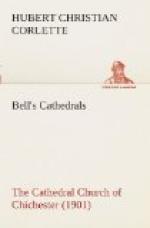[Illustration: Pier-capitals in the retro-choir. From a photograph by S.B. Bolas & Co.]
Some new buttressing had been added to the south-west tower when the upper part of the tower itself was rebuilt; but the larger works were the addition of a vaulted sacristy in the corner between the west side of the south end of the transept and the nave. On the opposite side of the same part of the transept a square-ended chapel with a vestry attached was added in place of the original shallow apsidal chapel. The original chapel on the east side of the north end of the transept was also removed to make way for another and much larger one. This is now used as the cathedral library.
The scheme planned after the second fire having been completed by about the middle of the thirteenth century, little further work was undertaken in comparison with that then finished; but before 1250 the wall of the south aisle of the nave was pierced in four bays, and two more chapels were added. Then, on the north of the nave, the outer wall of the aisle was cut through in the second bay, going west from the transept, and a small chapel was built. The other chapels west of this one were added during the latter half of the century. In each case the deeply projecting buttresses which had been introduced against the earlier walls after the second fire were used, where they were available, to form parts of the masonry of these new chapels, and were therefore not disturbed unnecessarily. The old walls having been altered, and the earlier buttresses being changed in their nature, it became necessary to carry the original thrust from the nave still farther out from its source in order to find for it some satisfactory abutment, and in doing this there was that new force, introduced by the vaulting of these added chapels, to be reckoned with in addition. Consequently, to the earlier buttressing more was added. The exact nature and the approximate date of this work are shown by Professor Willis in the sections and plan given in his monograph on the cathedral. The addition to each buttress amounted to an elongation of it as a pierced wing wall which provided lateral support. Upon the end of it a greater mass of masonry was introduced to serve as a weight for steadying the structural device; and this necessary structural idea was the means of introducing another architectural feature—the pinnacle. Between the pinnacles of these buttresses rose the gabled ends of each of the chapels. Professor Willis suggests that a great part of the work done after the fire of 1186-1187 was completed by the time of the dedication ceremony in 1199, and he is no doubt a safe authority to follow. But the nature of many architectural features tends very strongly to confirm the idea that much of the work in the ambulatory eastward of the sanctuary had been delayed. It may have been that the activity which prevailed during the early




